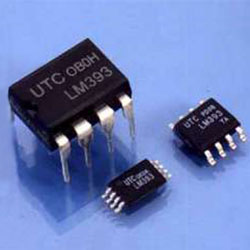
Combined with a 7.2 MHz gain-bandwidth product (min of 4.5 MHz), power supply range of a single +3 V to ±18 V, typical slew rate of 2.5 V/microsecond (min of 1.7 V/microsecond), a low 1/f corner of 13 Hz (the 1/f corner is where the noise density begins climbing with a 1/f amplitude characteristic).
The only quibbling area is THD+N. The data sheet states it is (typically) 0.0006%—very impressive, except that this is for unity gain, and a 10 VP-P, 1 kHz signal. The 1 kHz THD+N degrades to 0.04% for a 1 VP-P signal in a x100 gain application, and no information is given for 20 kHz THD+N under the same conditions (or for any other frequencies).
The data sheet graphs indicate the THD+N has a knee around 2 kHz where it climbs rapidly. Nothing to be alarmed about, but it should be understood when measuring high frequency THD+N.
Analog Devices selections in this low voltage category include one standout: AD8517/AD8527 featuring operation at 1.8 volts, with 7 MHz gain-bandwidth, 7 V/m s slew rate, and 15 nV/Ö Hz (all numbers typical—no min/max given).
THD+N is a respectable 0.03%, amazingly flat across the whole audio range (no 1/f corner shown down to 10 Hz, which probably says this is noise dominated and not distortion at all), with a smooth bump to 0.04% at 10 kHz and then back to 0.03% at 20 kHz.
A couple of interesting things to note about this part’s THD+N behavior: the figures given above are for 1.8 volt operation, if this is increased to 3 volts, or greater, then the THD+N plunges to 0.001% (flat from 10 – 20 kHz). And there is this interesting comment on page 11: “If an inverting configuration, the noise (note the comment is “noise” not “THD+N”) is 0.003% for all VSY.” So the rule for this part—if you only have 1.8 volts—is to always use it in inverting configurations.
Moving up the power supply voltage ladder a bit, if you have succeeded in creating at least ±5 volts to work with then you can use another ON Semiconductor part, the MC33078/MC33079 family of dual and quad op amps.
With typical high gain-bandwidth product of 16 MHz (10 MHz min), slew rate of 7 V/microsecond (5 V/microsecond min), noise density of 4.5 nV/per square-root-Hz (1 kHz typ), and THD+N = 0.002% (typical, 20 Hz to 20 kHz, unity gain, and 1 V out—increasing to 0.01% for x10 gain and maximum output), combined with low price, makes this is a very hard part to beat.
From Analog Devices there is the OP275, a superb audio IC. Characterized with a 9 MHz (typ) gain-bandwidth product, minimum 15 V/m s slew rate, a flat noise spec of 6 nV per square-root-Hz (typ) over the whole audio range, and a typical THD+N performance of less than 0.001% from 20 -10 kHz, only rising slightly to 0.002% at 20 kHz.
Word to the wise: do not use Analog Devices’ SSM line of ICs for new designs. (The remaining SSM ICs represent the end of an innovative line of audio integrated circuits created in the early ‘80s by Solid State Micro Technology for Music (SSMT).
Their unique and useful audio ICs were all prefixed SSM. Precision Monolithics Inc. (PMI) bought out SSMT in the late ‘80s, and then Analog Devices acquired PMI in 1991.) Even though they are shown in their Single Supply Amplifier selection guide under Audio—do NOT use them for new designs.
